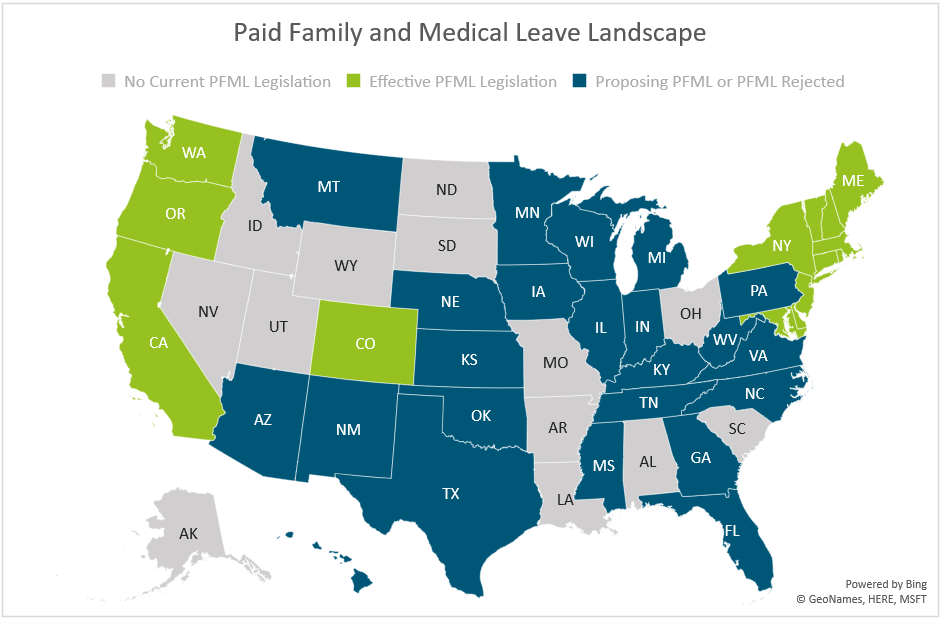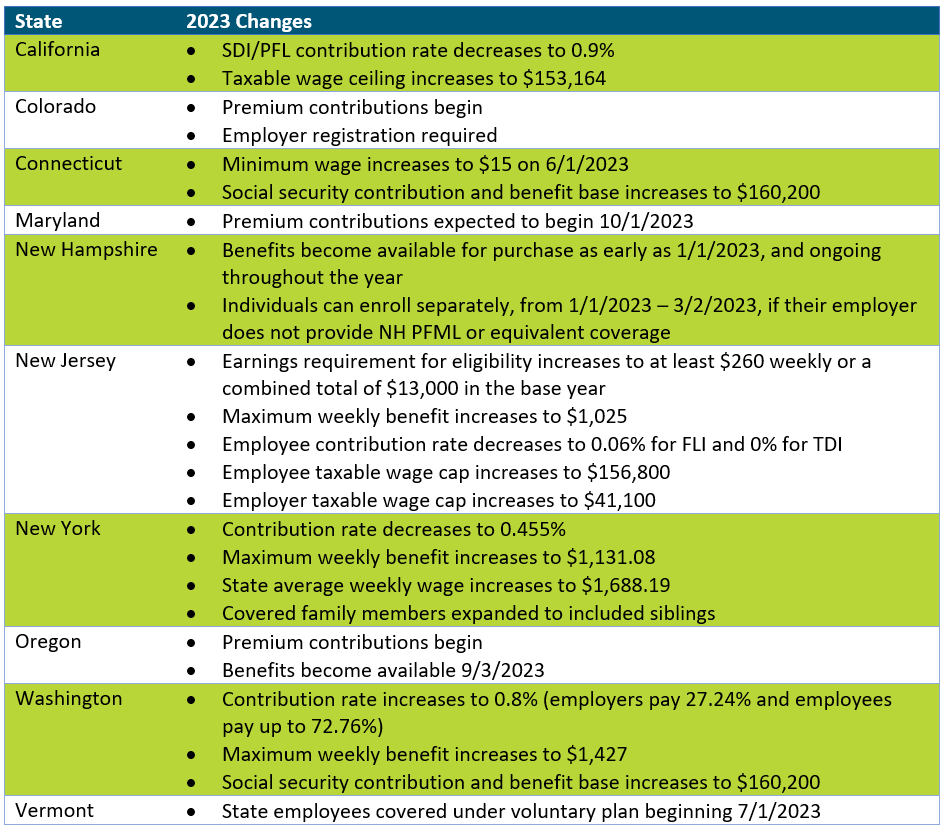As seen in the New England Employee Benefits Council (NEEBC)’s blog.
Last year around this time, I gave a year-one progress report on the Massachusetts Paid Family and Medical Leave (PFML) program, as it had finished its first year of paying out benefits to eligible workers. Since then, the MA PFML program has continued to mature and adjust according to experience, and, around New England, Connecticut has had PFML benefits available for one year, and there are related updates from Rhode Island, New Hampshire, Vermont and Maine to report.
Massachusetts: A Year in Review
In fiscal year 2022 (July 1, 2021 – June 30, 2022), the Massachusetts Department of Family and Medical Leave (DFML) experienced1:
– Over 112,500 applications, with 20% being denied
– 59% of applications were related to medical leave, 31% for bonding, and 10% to care for a family member
– Only 32 approved applications for military exigency leave and 7 approved applications to care for a service member
– Claimants aged 31-40 had the most approved claims (40%) and more than 1.5 times as many women had an approved leave (61% of claims), compared to men (35% of claims)
– Average weekly benefits were $793.55 for family leave and $754.84 for medical leave
– Turnaround times from the time the application was submitted to an initial decision was a median of 17 calendar days
– Average duration of leave was 12 weeks, assuming a 5-day work week
– Total benefits paid was equal to about $603 million (an increase of about 245% from FY21 which accounted for January 1, 2021-June 30, 2021)
In 2023, Massachusetts will be updating maximum benefit amounts and reducing total contributions.
– The maximum weekly benefit is increasing to $1,129.82, effective 1/1/2023. This is an increase of about $45 from the 2022 weekly maximum. For any employees who may have leave that runs from 2022 into 2023, the weekly benefit that was determined when leave was approved will continue. The new maximum will not be applied until there is a new MA PFML leave application.
– Contributions, however, will be reduced in 2023. The total contribution is decreasing from 0.68% to 0.63%, for employers with 25 or more covered individuals. The medical leave contribution will be 0.52%, with employers funding 0.312% and employees responsible for up to 0.208%. The family leave contribution will be 0.11%, with employers able to collect the total contribution from employees. Employers with less than 25 employees are not required to submit the employer portion of premium.
The financial earnings requirement was also updated in 2023. Employees must have earned at least $6,000 and 30 times the PFML benefit amount during the base period to be considered eligible for MA PFML.
Connecticut: First Year Activity
Connecticut has now had PFML benefits available for 1 year. During the first six months of the program2:
– Over 44,127 applications, with 40% being denied of those that received a decision
– 44% of approved applications were related to medical leave, 29% for bonding (own child and adoption/foster care), 18% for pregnancy/childbirth, and 9% to care for a family member
– Only 15 applications were approved for family violence, 12 for organ and bone marrow donation, and 2 for qualifying exigency
– Claimants aged 26-41 had the most filed claims (53%) and more than double the number of females applied for leave (28,814), compared to males (14,213)
– Average weekly benefits paid were $562.01
– Average approved duration of leave was 6.79 weeks
– Total benefits paid was equal to about $81 million
– Almost 137,000 businesses have registered with the CT Paid Leave Authority and claim applications have been received from every city and town in the state
Based on the experience in the state in 2022, Connecticut is not making any major changes to the program in 2023. However, the social security contribution and benefit base increased to $160,200 on January 1, 2023, and CT minimum wage increases to $15/hour on June 1, 2023, which will impact benefit and contribution amounts.
Please note that the program has some key differences when compared to MA PFML, such as the availability of leave for organ and bone marrow donation, as well as leave related to family violence. Differences in benefit amounts, leave duration, and eligibility conditions also make it difficult to directly compare CT and MA PFML experience.
Other New England Updates
Massachusetts and Connecticut are not the only New England states to be seeing PFML progress. Rhode Island has an established temporary disability insurance program (TDI), which was the first statutory disability program in the country, established in 1942. In 2014, they became the third state to offer family leave benefits through temporary caregiver insurance (TCI). In addition, the state does not allow private plans, making the model slightly different than other PFML programs in the region. On January 1, 2023, a few updates to TDI and TCI became effective. The state’s taxable wage base increased to $84,000, which will impact the contribution calculation. The benefit duration also increased to 6 weeks, from 5 weeks in 2022. Finally, the financial eligibility conditions claimants must meet increased so that employees must have paid at least $15,600 in the base period or meet the alternative conditions wherein they earned at least $2,600 in one of the base period quarters and base period taxable wages equal to at least $5,200.
A new outlier is New Hampshire’s first-in-the-nation, state-sponsored voluntary plan where NH employers and eligible NH workers can purchase a paid family and medical leave plan through the state’s insurance carrier. New Hampshire selected MetLife as its insurance partner and began paying benefits on January 1, 2023.
Similarly, Vermont spent 2022 developing a voluntary program to be administered by The Hartford, their selected insurance carrier. Beginning July 1, 2023, state employees will be covered under the program, with other private and public employers with 10 or more employees eligible for coverage in 2024, and small employers and individuals able to purchase coverage in 2025.
Maine also made strides in developing the structure of their state mandated PFML program. Maine created a commission to study PFML programs and to propose a PFML model for the state, which kicked off in May 2022. Policy recommendations are expected to be presented to the Legislature in 2023.
Are You Up to Speed?
As the PFML landscape continues to evolve at the local, state and federal leaves, policies need to be monitored on an ongoing basis. Employers should ensure they are compliant with the requirements of each individual leave program, as differences exist between all established paid family and medical leave policies. If any of your employees are impacted by a state PFML policy, organizations should review plans, policies, and processes to confirm they are in line with any legislative changes. To do so, the following checklist can be followed:
– Register in any new states where employees are located, if required
– Ensure contributions are being collected appropriately
– Update employee notices and benefit documentation, as appropriate
– Confirm employee count to determine if any changes to contributions are required
– Review private plan strategies based on previous year experience and changes to contributions
– Renew private plans as appropriate
– Validate company sponsored leave programs coordinate with PFML to the extent possible
If you need assistance ensuring PFML compliance or to assess the optimal plan set up for your organization, Spring’s consultants are happy to help www.springgroup.com
Paid Family and Medical Leave continues to be a confusing point for employers, compounded by new legislation being proposed at a seemingly constant pace. As leaders in the disability and absence management space, we are dedicated to staying on top of updates around PFML, among other areas. After a busy year in that regard, with another on the horizon, we wanted to share this brief overview.
In 2022, there was more movement towards state PFML laws being passed after decreased activity in previous years, largely due to the COVID-19 pandemic. For example:
- Delaware and Maryland both passed laws establishing PFML programs
- Virginia established insurance rules, allowing carriers in the state to provide insured PFML plans to clients
- Colorado and Oregon began collecting contributions on 1/1 and have been working to ensure they are prepared to do so, while establishing other rules for the effective administration of PFML
- New Hampshire worked to develop their voluntary PFML program selecting MetLife as its insurance partner and began coverage on 1/1/2023
- Vermont selected The Hartford as its insurance partner for its voluntary PFML program
- Maine made strides in developing the structure of their state mandated PFML program
In 2023, we expect continued activity. Pennsylvania and Michigan have outstanding proposals for PFML, which will likely be decided upon in 2023, one way or another. Additional states may also put forward proposals in upcoming legislative sessions.
In addition, and as seen in the updates below, states with existing legislation continue to make adjustments to their PFML programs. Adjustments to contributions and benefits are typically expected, most commonly, but not always, at the end of the calendar year.
The map below shows a summary of states with existing PFML legislation and programs in place, those who have proposed legislation without it being passed, and those that have not had any activity related to PFML in recent years.

Massachusetts
In 2023, Massachusetts will be updating maximum benefit amounts and reducing total contributions.
The maximum weekly benefit is increasing to $1,129.82, effective 1/1/2023. This is an increase of about $45 from the 2022 weekly maximum. For any employees who may have leave that runs from 2022 into 2023, the weekly benefit that was determined when leave was approved will continue. The new maximum will not be applied until there is a new MA PFML leave application.
Contributions, however, will be reduced in 2023. The total contribution is decreasing from 0.68% to 0.63%, for employers with 25 or more covered individuals. The medical leave contribution will be 0.52%, with employers funding 0.312% and employees responsible for up to 0.208%. The family leave contribution will be 0.11%, with employers able to collect the total contribution from employees. Employers with less than 25 employees are not required to submit the employer portion of premium.
Other State Updates
Other states have made updates to their programs effective January 1, 2023, unless otherwise noted below. Some states may make changes off calendar year (e.g., District of Columbia, Rhode Island), which are not included if they have not yet been released.

Recommended Approach
Employers should review their PFML plans, policies, and processes to confirm they are in line with any legislative changes. To do so, the following checklist can be followed:
– Update employee notices and benefit documentation, as appropriate
While formal notices may not always be required, especially if contributions are decreasing, communicating updates to employees is recommended, especially if the change will impact their pay. Most states provide sample notices that can be customized to fit an employer’s needs. Keep in mind that there may be timing requirements in place (e.g., 30 days in advance).
– Confirm employee count to determine if any changes to contributions are required
Some states require contributions from both employers and employees however do not require employer contributions from “small” employers. This definition of small varies by state (e.g., less than 25, less than 50 employees). Confirming the total number of employees will verify the contributions being remitted to the state are accurate.
– Review private plan strategies based on previous year experience and changes to contributions
Whether or not a private plan is an ideal method for an employer to provide PFML to employees may vary from year to year. This can largely be based on the cost of a private plan versus going with the state plan, but the employee experience also plays a major role. From a cost perspective, a private plan, in most states, will be based on that employer’s leave experience. If an employer has high PFML incidence rates, insurance carriers or TPAs may charge more than is required to be paid under the state plan. From an employee experience perspective, having to file PFML claims to the state and what are often concurrent disability, FMLA or other leave claims to the employer or its vendor partner, can be confusing and require more effort for both employees and employers. While the driving factors will vary by employer, both cost and employee experience should be considered.
– Renew private plans as appropriate
When a private plan is in operation, states may require these be renewed at certain intervals. Massachusetts, for instance, requires this annually, while Connecticut only requires it every three years, unless a material change to the plan is made. Employers should review the timing of their private plan approval and guarantee it is up to date.
If you need assistance ensuring PFML compliance or assessing the optimal plan set up for your organization, Spring’s consultants are happy to help.
It is estimated that ~44 million Americans are experiencing long COVID symptoms. During a recent Spring webinar, our SVP, Teri Weber was joined by a pulmonologist and a representative from Goodpath to review common long COVID symptoms and how it is impacting productivity and claims. You can access the webinar here.
Spring has been selected to help the Maryland Department of Labor (MDL) more effectively implement and administer the Family and Medical Leave Insurance (FAMLI) Program. Check out the press release here.
Our Senior Vice President, Teri Weber published an article explaining how employers can better gauge the efficiency of their leave management programs and highlight areas for process improvement using the secret shopper model. Check out the full article published by the Disability Management Employer Coalition (DMEC) here.
Coming out of our COVID haze, it can be difficult to remember a time when employers could be truly strategic and proactive without priorities evaporating due to lockdowns, staffing shortages, travel bans or taking a U-turn due to pressures in other areas of the business. The time is now to pivot back to your strategic plans related to employee benefits. We recommend the road to an optimal benefits program be lined with solutions to specific pain points and cultural considerations at your organization. However, I advise at least considering the following within your strategic roadmap to see if they are a fit and can close gaps within your current program.
1) Employee Surveys
Priorities within your workforce have likely changed considerably in the past two to three years. If you haven’t asked employees about their priorities related to employee benefits, it is time! Some of your more traditional benefits or office-affiliated perks that may have been linked to attraction and retention in the past are no longer a value add to employees. It is not enough to talk about perks and flexibility; needs must be better understood to ensure you are providing something that actually attracts and retains talent, instead of the
2) Lifestyle Accounts
Financial accounts within employee benefits are not new (e.g., a Flexible Spending Account), but recently employers have started using these account-based perks in different ways to fill a gap that exists in their offering while providing ultimate flexibility. These accounts are taxable but can be used within the parameters set by the employer. Organizations may use them to support just about anything, but common categories today include:
– Medical procedures that may not be covered within the medical plan (i.e., infertility services, elective procedures, etc.)
– Travel expenses for medical services
– Family-focused benefits (i.e., doula, etc.)
– Legacy wellness support (i.e., fitness equipment, fitness classes)
The beauty of these services is that they can be selected based on employee needs as well as organizational culture and budget.
3) Absence Policies and Processes
Diversity, equity, and inclusion (DEI) are at the top of the list of internal initiatives, and goals are uniquely defined based on how much progress has already been made. It goes without saying that DEI is critical to the success of all companies, but I think a key area of DEI that requires some additional attention is your corporate absence strategy. Over the past few years, organizations have developed additional absence policies around COVID-19 and Monkey Pox, but there has also been a large push toward more family-focused leave of absences surrounding bereavement, parental leave, and the like. It’s important that DEI initiatives within employee benefits focus not only on the services but also on the time off that may be required, and viewing this through the many lenses of your diverse workforce.
4) Oncology Support
As benefits professionals, we have worked diligently to identify point solutions for high-cost and highly disruptive conditions. While point solutions continue to be part of a strong strategy, most employers have or will see an increase in oncology prevalence and spend due, in part, to expensive treatments but primarily driven by disrupted or delayed care and screenings.
Initial concerns with COVID-19 not only decreased primary care visits but snowballed, as providers later had limited appointments available due to overwhelming demand, which has translated into undiagnosed cancers. Now as participants are getting back to their primary care physicians, many cancers have progressed further or upstaged, creating the need for more intense and complex treatment.

In addition to the direct cost of cancer care, employee productivity is significantly less after a cancer diagnosis, even if that diagnosis is within their extended family.
Spring encourages employers to seek a proactive and holistic approach to oncology support, including some or all the following:
– Monitor screening engagement
– Encourage prevention including reminders and other communications; consider incentives
– Educate and support initial and ongoing care decisions
– Concierge support
– Clinical support
Of paramount importance is to educate and engage employees before a diagnosis, so they know where to go for initial support. Those first few weeks after a diagnosis are critical to setting the stage for appropriate treatment and clinical review and/or second opinions. There are some free and buy-up options in the market provided by top-tier cancer care providers/facilities. Those have brand recognition and are designed to provide unbiased support but, in many cases, they also funnel patients to their service centers. Another consideration available is point solutions that are agnostic to cancer care providers/facilities and provide concierge support but do have an add-on charge, typically as a per employee per month (PEPM) or per referral model.
5) Healthcare Disparities
One of the most complex items that should be on your roadmap is to examine what healthcare disparities exist in your population. For starters, ensure multilingual communications are available to close healthcare gaps for those with language barriers. From there, it is important to begin to stratify your population – if your size warrants – and begin to examine if health outcomes are impacted by race, location, earnings, and/or other social determinants of health. This strategic initiative must be performed in collaboration with your insurers and third-party administrators and will take dedicated time to set a methodology and refine your findings over time. The key is to at least get started by looking at the data and talking about how you can improve your understanding of the current state to work toward better data in the future.

Setting the strategic plan for your employee benefit package should be customized to your organization’s priorities and complexities that are identified through claims experience and survey information. Given each organization has its own culture, demographics, and business priorities, it is impossible to set a perfectly standard list of considerations when it comes to your employee benefit strategy. But as you drive toward the best vision for your company – off in the horizon – be sure to stop along the way to check out these five hotspots of benefits planning.
Spring frequently helps employers assess different solutions, plans, and programs and build them into their roadmap. One client, edHEALTH, is currently organizing three solution committees to refine areas of opportunity and prioritize solutions based on demand and change readiness.
Whether or not we have seen the worst of The Great Resignation, savvy employers are not new to adjusting their benefits and “perks” programs to better align with workforce desires. At the Disability Management Employer Coalition (DMEC) Annual Conference last week in Denver, I spoke specifically on whether Flexible Time Off (FTO) has taken over as the frontrunner, versus the more traditional Paid Time Off (PTO) approach. I thought you might be curious to know the answer, at least in my opinion, so I’m jotting down the key points from my presentation here.
Background
As with so many things in business and in life, in order to clearly understand the current state of PTO, it’s critical to look back at the history of the concept. In 1910, President Taft proposed 2-3 months of required vacation, “in order to continue his work next year with the energy and effectiveness which it ought to have.” Countries like Germany, Sweden, and others were no strangers to this idea, and set forth on setting global standards regarding minimum levels of vacation. Today, the U.S. is one of only six countries in the world – and the only industrialized nation – without a national paid leave policy. So, what gives?
At least on paper, Americans seem to prefer work over vacation. You may be laughing or rolling your eyes, but it is a fact that significant time off goes unused at the end of the year (people choose to lose it rather than use it). In some cases, this may be the result of a corporate culture that, while they may document PTO programs, do not actually encourage the use of that time. If you’re expected to work while on vacation, you may not feel it worthwhile to take said vacation.
PTO
Over the years additional policies popped up to fill some of these gaps, such as leave related to COVID-19, sick leave, disability, parental leave, and family leave. Many organizations arrived at a PTO program in which an allocated number of days account for different types of leave which vary by employer, but might include vacation, bereavement, sick and personal leave. While this creates efficiency and reduces unscheduled absences, this design (perhaps inadvertently) encourages working while sick, as employees do not want to use days within their bucket when they have a cold, since those same days could be used on a tropical vacation or, on a less happy note, in the case of a personal or family emergency. This flaw went from acceptable to unacceptable in light of the pandemic, and turned some organizations off of PTO and on to FTO.
FTO
Flexible Time Off (FTO) allows for ultimate flexibility in the volume of “vacation” time taken. With the expectation that employees do their jobs, meet deadlines and achieve their individual and corporate goals, time for rest is scheduled at the discretion of managers. FTO however is not to be confused with unlimited vacation days. While a nice idea, some challenges exist around FTO, including:
- FTO plans are unlikely to meet the needs for vacation plans and sick/safe plans, and are not recommended to fulfill all of these requirements given federal and state law complexities
- Performance management and manager training is critical with this design
- Be careful about creating guidelines around the number of acceptable days off, because it can quickly morph into a PTO plan with wage liability
- Participation in FTO plans for non-exempt employees is not recommended as it will result in payroll obstacles and litigation susceptibility
Given these factors, however, FTO plans can be a powerful organizational tool. If you’re considering FTO, I recommend first answering the following questions:
- Which population should be considered for FTO?
- What approach will ensure managers are managing workload instead of time off?
- What scheduling and approval processes will be implemented?
- How will you ensure employees have the opportunity to leverage their FTO?
- Are you accounting for sick/safe requirements through another policy/program?
- How will you answer to the stigma that FTO is designed to decrease utilization and save you (the employer) from PTO liability?

The Big Reveal
FTO can bring a lot to the table for an organization: it is unlikely to result in more time off (than before), it is financially savvy, a good recruiting tool, and relatively easy to implement. On the flip side, however, I noted some real challenges. In the end, and if you read this article for the clickbait title, my investigative answer is no: FTO is not the new PTO. It should however be considered as one tool within the absence management toolbox, and assessed according to your individual employer needs and priorities.
After a short hiatus, The Disability Management Employer Coalition (DMEC) was able to host their 2022 Annual Conference in-person for the first time since the pandemic started. DMEC is one of the leading organizations in the paid leave industry and their annual conference brings together employers, vendors, government officials, lawyers and more to network and discuss leading trends in the business. This year also marked the 30th anniversary of the creation of DMEC, furthermore solidifying itself as a staple in the world of disability management. It was great seeing so many familiar faces from the industry and learning more about what’s keeping industry professionals up at night. This year’s conference took place in Denver, CO and Spring had the pleasure of both exhibiting and presenting.
Although this year’s conference covered a wide range of topics, I noticed the following three key themes.

1) FMLA & ADA Challenges
Although compliance is often a hot button topic at DMEC, this year there was a specific emphasis on maneuvering around FMLA & ADA challenges. Presenters tackled FMLA & ADA challenges from a range of angles including changes in guidance, a Q&A with federal agency leaders, and a mock trial where the attendees acted as the jury. Some of the of the FMLA & ADA related presentations this year included:
- Helen Applewhaite, Director of the FMLA Division at the Department of Labor (DOL) was interviewed on employer challenges under these laws and key DOL and EEOC priorities in a session titled “A View from the Top: Current FMLA and ADA Challenges”.
- In a session titled “Recent ADA and FMLA Trials: Employer Wins and Losses,” experts included interactive polls where attendees could predict jury outcomes from previous FMLA & ADA trials.
- Lastly, compliance experts from ReedGroup and an Absence Management expert from The Guardian conducted a mock trial titled “Law & Order: DMEC Edition,” where presenters took roles of the judge, plaintiff, defense and plaintiff’s attorneys, and the attendees acted as the jury responding to employers breaking FMLA & ADA regulations.
2) Support for Caregivers and Healthcare Workers
Although COVID has settled a bit in severity, caregivers and healthcare workers are still facing high rates of burnout and overworking, without receiving much federal support. Also, in the past 50 years we have seen the highest rates of children and elderly parents in the home, often requiring some type of care, most often unpaid care by a family member. During this year’s conference, presenters tackled the issue of mental health for employees assuming the role of a caregiver and how employers can offer needed support. Below are some of the groundbreaking presentations tackling this issue.
- Experts from the Lincoln Financial Group explored solutions employers can adopt to support employees who act as caregivers in their “Caring for the Caregivers: A Key to Employee Retention” session.
- The Standard’s Dan Jolivet looked at common stressors healthcare workers face that lead to fatigue and turnover in the healthcare industry and brainstormed possible solutions in his “Costs of Care: The Impact of Stress and Compassion Fatigue on Healthcare Workers” presentation.
3) The Future of Leave
As we tentatively look beyond the COVID-19 era, there was a huge emphasis this year on what we can expect from the disability and leave management industry moving forward. During the pandemic many employers adjusted to remote/hybrid leave policies, introduced new mental health resources and navigated changing COVID regulations. But as we slowly move into a post-COVID world, many speakers, such as those noted below, looked at new-age alternative leave policies and what we can expect for the future of leave.
- Representatives from Unum explained how previous leave programs are not working for today’s workforce and a one-size fits all approach is not suitable for most employees in their “Leave Is Changing: Are You Changing With It?” presentation.
- Spring’s SVP, Teri Weber evaluated whether flexible time off policies could be a viable replacement for traditional PTO policies in her “Is FTO the New PTO?” session.
- Leave specialists from Brown & Brown, FINEOS, New York Life Group Benefit Solutions and Spring looked at “How [Employers Can] Harness Market Forces to Meet Future Absence Management Challenges.” Some of these market forces discussed included Instagram, the gig economy and federal paid leave policies.
a) Utilizing Tech & Data
When looking at the future of leave management, we are seeing a giant increase in leave related tech and software, which allows employers to better understand leave trends and preferences within their workforce. Although tech and data collection software are not new in the industry, we are seeing constant updates and an influx of new software that help measure different facets of absence management policies. Below are a few tech & data related sessions we wanted to spotlight.
- AbsenceSoft’s CSO and CCO showcased how data is key in managing eligibility, entitlement, workflow process and more, as well as common mistakes to avoid when designing a data strategy.
- One panel presented on “Improving the Employee Leave Experience through Technology”, in which they reviewed how tech can expedite the collection of medical documents, identify opportunities for wellness programs and more.
- When it comes to implementing Absence Software, it can be tricky selecting the right program. A discussion including CVS Health and CommonSpirit Health spoke on best practices when selecting and implementing a software-based solution.
b) Moving Past COVID-19
As many organizations slowly move back into the office, employers have been developing and reassessing return-to-work programs and reevaluating leave policies to keep their workforce happy. On a national level, we are seeing changes in COVID-related compliance and a big push to retain talented employees through enhanced benefits packages. Here are some noteworthy sessions related to adjusting to a post-COVID world.
- In a presentation titled “Life Beyond COVID: New Focuses for Absence & Disability Compliance”, representatives from Jackson Lewis review the long-lasting effects of new leave legislation.
- Experts from Voya Financial and FullscopeRMS’s Claims Director, Katie Hunt shared recent research to help enhance leave management and return-to-work programs.
- Another panel including DMEC’s CEO, Terri Rhodes tackled feedback and questions from the audience on challenges for absence management teams, return-to-work programs and ADA accommodation processes.

All in all, being back at the DMEC Annual Conference in-person was a powerful experience! This year I saw so many young and enthusiastic faces which is a good sign for the future of the industry. DMEC never fails to provide innovative insights into the absence and disability management landscape while providing a fun and interactive experience, and I am already looking forward to their next event.
This year marks the 30th anniversary of the formation of the Disability Management Employer Coalition.
Check out this background on DMEC, including inputs from our Senior Vice President, Karen English.